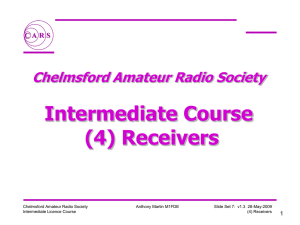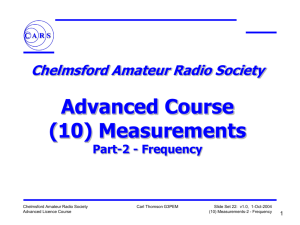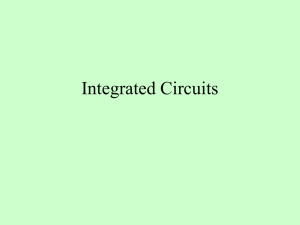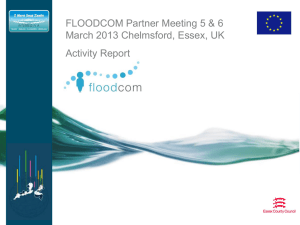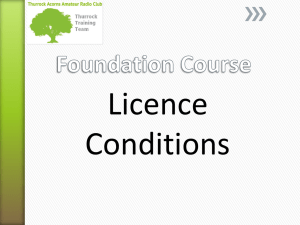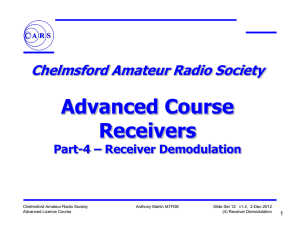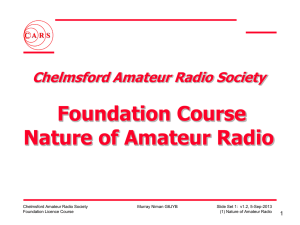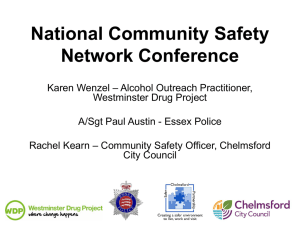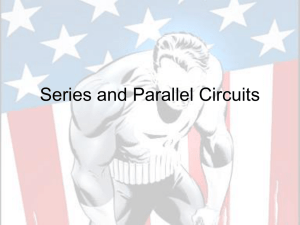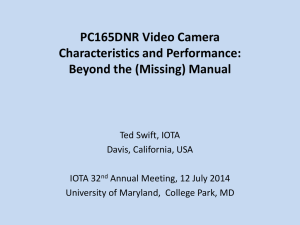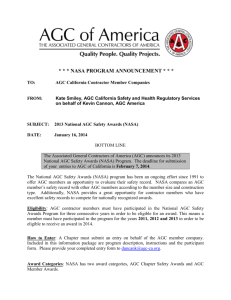Aslide11-Receivers-3 - Chelmsford Amateur Radio Society
advertisement
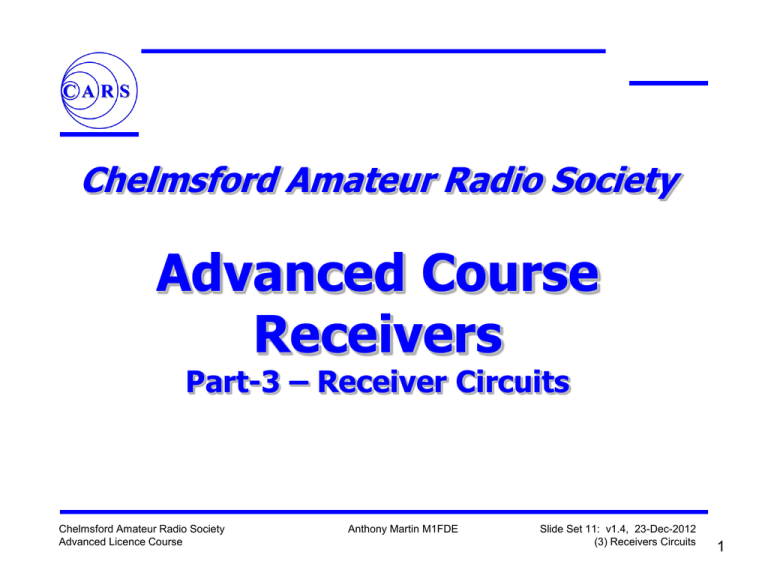
Chelmsford Amateur Radio Society Advanced Course Receivers Part-3 – Receiver Circuits Chelmsford Amateur Radio Society Advanced Licence Course Anthony Martin M1FDE Slide Set 11: v1.4, 23-Dec-2012 (3) Receivers Circuits 1 Receiver Circuits Common circuits in receivers:• IF amplifiers • IF transformers • LC coupled pairs • AGC amplifiers • Obtaining the AGC voltage Chelmsford Amateur Radio Society Advanced Licence Course Anthony Martin M1FDE Slide Set 11: v1.4, 23-Dec-2012 (3) Receivers Circuits 2 Colpitts Oscillator • The LO may be provided by a tuneable LC or fixed crystal oscillator • Often followed by a buffer amplifier – To increase mixer drive level – To prevent feedback from strong input signals affecting the oscillator R1 6.8k +9V +9V R3 1.5k R3 1.5k R1 100k Out TR1 TR1 C1 R2 1.5k 100n C XL1 Crystal Chelmsford Amateur Radio Society Advanced Licence Course C2 C1 R2 68k L R4 1.0k Out 5-35pF Anthony Martin M1FDE C2 R4 1.0K Slide Set 11: v1.4, 23-Dec-2012 (3) Receivers Circuits 3 IF Amplifier +9V IFT2 • Tuned circuits provide selectivity • Transistor provides gain • AGC line varies the bias current to control the gain Next stage Previous stage IFT1 • Used in multiple stages – higher gain, more selectivity TR1 100n 100n AGC line Chelmsford Amateur Radio Society Advanced Licence Course Anthony Martin M1FDE Slide Set 11: v1.4, 23-Dec-2012 (3) Receivers Circuits 4 Coupled-Pairs • Coupled pairs can be used to provide frequency selectivity in IF stages – Used to be common in Valve IFs (fewer stages) but transistor IF transformers are single-tuned Critical coupling Primary Secondary Overcoupled C Undercoupled C L L Mutual inductance coupling Chelmsford Amateur Radio Society Advanced Licence Course Frequency Response Anthony Martin M1FDE Slide Set 11: v1.4, 23-Dec-2012 (3) Receivers Circuits 5 Coupled-Pairs • Inputs and outputs can be inductive-taps or capacitive taps • Coupling may be by physical L or C as well as mutual inductance • Usually seen in various forms in VHF transceiver frontends Coupling Output Input Chelmsford Amateur Radio Society Advanced Licence Course Anthony Martin M1FDE Slide Set 11: v1.4, 23-Dec-2012 (3) Receivers Circuits 6 Shape Factor • Shape Factor is a measure of rejection for large unwanted signals • Shape Factor can be related to the number of tuned circuits in the IF 0dB • Shape Factor is the Ratio of the 6dB BW to 60dB BW –6dB –6dB BW –20dB • Typical shape factors are about 1.5 to 2.5 –40dB –60dB –80dB –15kHz –10kHz • Crystal filters may be used for shape factors narrower than 1.5 –60dB BW –5kHz Chelmsford Amateur Radio Society Advanced Licence Course 0kHz +5kHz +10kHz +15kHz Anthony Martin M1FDE Slide Set 11: v1.4, 23-Dec-2012 (3) Receivers Circuits 7 Generating AGC Voltage • Can be achieved by a simple diode detector +9V IFT4 Detected AGC Voltage Last IF Amp TR6 C2 Chelmsford Amateur Radio Society Advanced Licence Course Anthony Martin M1FDE R2 D1 Slide Set 11: v1.4, 23-Dec-2012 (3) Receivers Circuits 8 AGC Issues • The Detector “sense” must match the IF amplifiers – Decrease GAIN with increasing SIGNAL. • AM detectors are fine for AM or other modulation with a carrier • SSB has no carrier. No signal is present between words so more complex arrangements are used:– Fast attack, slow decay – Fixed “hold” time – Manual AGC controls may be provided • AGC may drive a meter for S-level • When using a separate Tx and Rx, your own Tx will overload the Rx:– Will take a long time for the Receiver AGC to recover – Can use a fast AGC, or implement a “receiver de-sense” line Chelmsford Amateur Radio Society Advanced Licence Course Anthony Martin M1FDE Slide Set 11: v1.4, 23-Dec-2012 (3) Receivers Circuits 9
